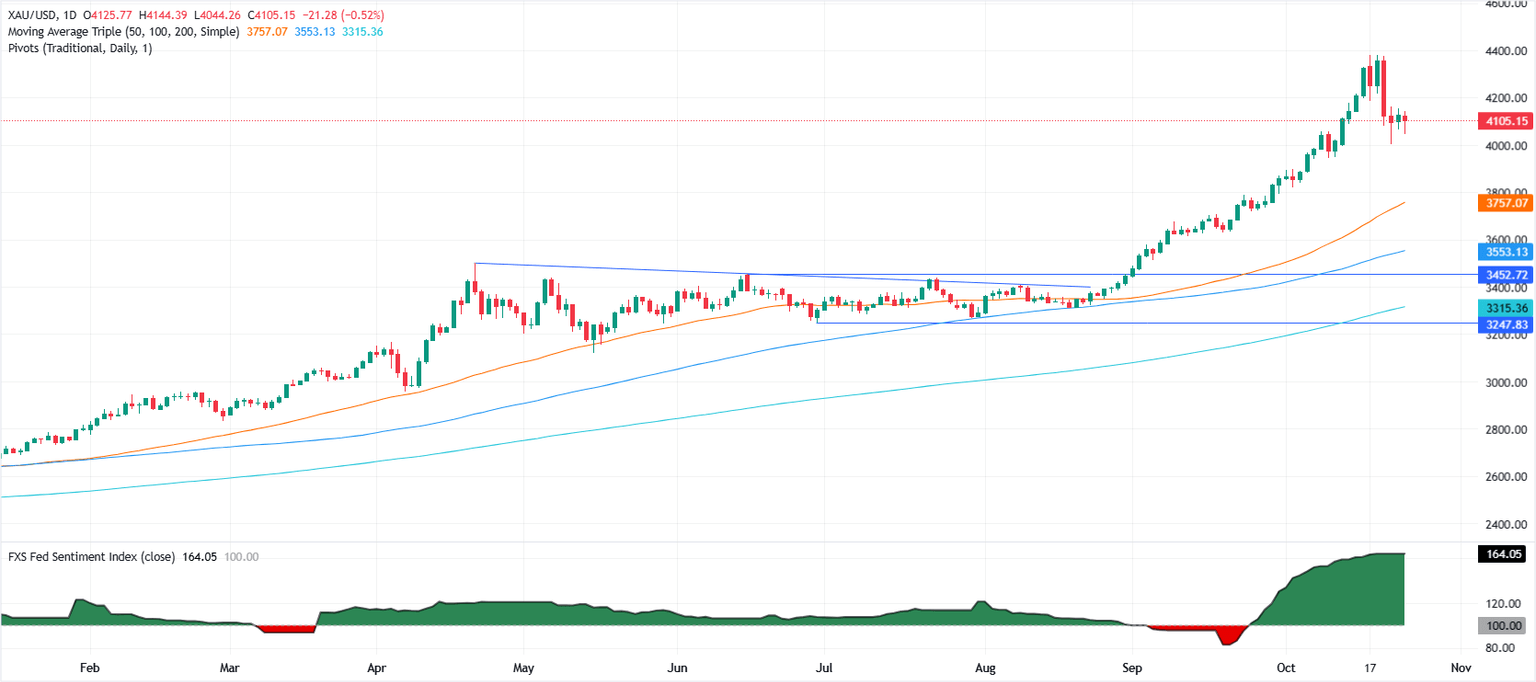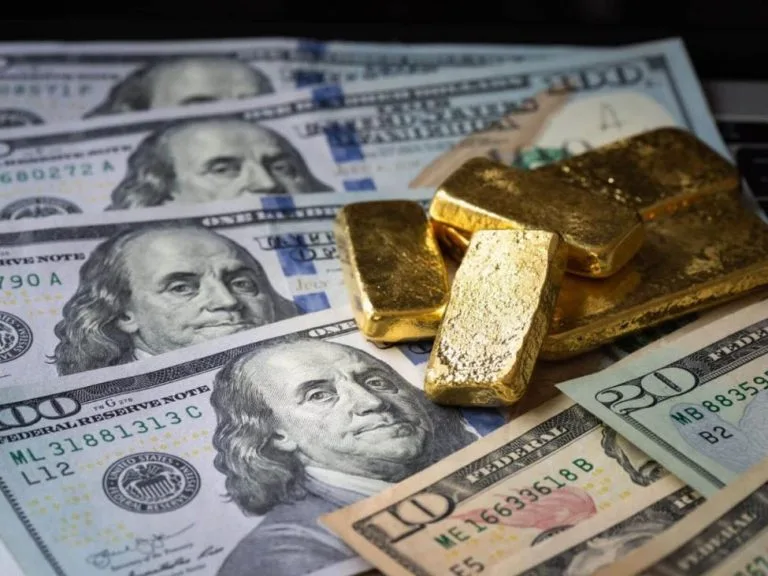Key Takeaways
- Gold prices experienced a rebound, moving up over 0.10% on Friday following the release of the US September inflation report.
- The inflation data, while showing an increase, was not deemed strong enough by traders to deter the Federal Reserve from potential rate cuts in the upcoming meeting.
- Market sentiment indicates a high probability, around 96%, for a Fed rate cut at the October 28-29 meeting.
- Geopolitical tensions, including sanctions on Russian oil companies and upcoming trade discussions between the US and China, continue to influence gold’s price movements.
- Gold has seen a significant year-to-date gain, attributed to geopolitical and trade concerns, strong central bank purchasing, and anticipation of US interest rate reductions.
Gold Rebounds as US Inflation Data Hints at Dovish Fed Policy
Gold prices reversed earlier losses on Friday, trading above 0.10%. This recovery followed the release of the US September inflation report, which indicated rising prices but was not perceived as a barrier to the Federal Reserve (Fed) considering interest rate cuts at their upcoming meeting. XAU/USD was seen trading at $4,127, having rebounded from daily lows of $4,043, buoyed by a Consumer Price Index (CPI) report that came in slightly softer than expected. While the data largely aligned with forecasts, it reportedly failed to provide ammunition for Fed hawks advocating against policy easing.
Traders Anticipate Dovish Fed Stance, Pushing Bullion Above $4,100
Traders appear to be pricing in a dovish outlook from the Federal Reserve, with the Prime Market Terminal interest rate probability tool showing a 96% expectation for a rate cut at the Federal Reserve’s scheduled meeting on October 28-29. This sentiment is circulating amidst broader economic indicators. S&P Global data suggested a pickup in business activity during October, while the University of Michigan’s Consumer Sentiment index saw a more significant deterioration in October than initially estimated in its preliminary reading.
Geopolitical Factors and Trade Tensions Impact Gold
The geopolitical landscape continues to contribute to market volatility. The White House announced that US President Donald Trump is scheduled to meet with Chinese President Xi Jinping in South Korea next week, a meeting occurring as the November 1 deadline for new tariffs approaches. Additionally, geopolitical events, such as sanctions imposed by the US on Russian oil companies Lukoil and Rosneft in relation to the Ukraine war, have introduced further fluctuations in the gold market.
The yellow metal has experienced a substantial increase of 55% year-to-date. This performance is attributed to a confluence of factors, including ongoing geopolitical and trade tensions, consistent buying from central banks, and the prevailing expectations of future interest rate cuts by the US central bank.
Market Movers: Gold’s Resilience Amidst Falling Treasury Yields
Despite a slight uptick in the US Dollar Index (DXY), which measures the dollar’s performance against a basket of six major currencies, gold prices have managed to hold their ground. The DXY was up 0.03% at 98.94.
- The yield on the US 10-year Treasury note decreased by 1.5 basis points to 3.989%.
- US real yields, which typically show an inverse correlation with gold prices, are also declining, down by approximately 1.5 basis points to 1.689%.
- The US CPI for the 12 months leading up to September rose by 3%, falling short of the anticipated 3.1% and showing a slight increase from August’s 2.9%. The ‘core’ CPI, excluding food and energy, expanded by 3% year-over-year, a tenth of a percent lower than the previous month.
- S&P Global’s Purchasing Managers’ Index (PMI) for business activity in the US showed acceleration in October, reaching its second-fastest pace of the year, according to preliminary ‘flash’ PMI data. This was accompanied by the most significant increase in new business observed so far this year.
- Specific PMI figures indicated the Manufacturing PMI at 52.2, an improvement from September’s 52.0. The Services Index rose to 55.2 from 54.2 in September, marking a three-month high.
- The University of Michigan’s consumer sentiment index was revised downward to 53.6 from a preliminary reading of 55.0, missing estimates of 55.1. One-year inflation expectations softened to 4.6% from 4.7% in September, while five-year expectations increased to 3.9% from 3.7% in the prior month.
- In an earlier development, JPMorgan projected that gold prices could reach an average of $5,055 per troy ounce by the fourth quarter of 2026. This forecast is based on assumptions of sustained investor demand and central bank purchases averaging around 566 tonnes per quarter next year.
Technical Outlook: Gold Buyers Target $4,200 Amidst Bullish Momentum
Despite briefly dipping below the $4,100 level and the 20-day Simple Moving Average (SMA) at $4,056, the uptrend for gold prices remains intact. The Relative Strength Index (RSI) suggests that bullish momentum is still present, but buyers will need to overcome a key resistance level to drive prices higher.
The immediate resistance is identified at the October 22 high of $4,161. A successful breach of this level could pave the way for further upward movement towards $4,200, followed by $4,250, $4,300, and ultimately the all-time high of $4,380. On the downside, the first level of support is seen at $4,100, with the October 8 high of $4,059 serving as the next significant support. A break below this could lead to a test of the October 22 low at $4,004.

Gold FAQs
What is the historical role of gold?
Gold has been a significant element throughout human history, valued as a store of value and a medium of exchange. Beyond its aesthetic appeal in jewelry, it is widely recognized today as a safe-haven asset, making it an attractive investment during times of economic uncertainty. Gold also serves as a hedge against inflation and currency depreciation, as its value is not tied to any specific issuer or government.
Why do central banks hold gold reserves?
Central banks are major holders of gold, often increasing their reserves to support their national currencies, particularly during periods of instability. Diversifying reserves with gold can enhance the perceived strength of an economy and its currency. High gold reserves can instill confidence in a country’s solvency. According to the World Gold Council, central banks added approximately 1,136 tonnes of gold, valued around $70 billion, in 2022, marking the highest annual purchase on record. Emerging economies like China, India, and Turkey have been notably increasing their gold holdings.
What are gold’s correlations with other assets?
Gold typically exhibits an inverse correlation with the US Dollar and US Treasuries, both of which are significant reserve and safe-haven assets. When the dollar depreciates, gold prices tend to rise. Gold also has an inverse relationship with riskier assets; a stock market rally can weaken gold prices, while sell-offs in riskier markets often benefit the precious metal.
What factors influence gold prices?
A variety of factors can influence gold prices. Geopolitical instability or fears of a recession can lead to price increases due to gold’s safe-haven status. As a non-yielding asset, gold tends to perform better in an environment of lower interest rates, while higher borrowing costs can put downward pressure on its price. The behavior of the US Dollar is a crucial determinant, as gold is priced in dollars (XAU/USD). A stronger dollar tends to cap gold prices, whereas a weaker dollar often pushes them higher.
Expert Summary
The recent US inflation data provided a slight boost to gold prices, indicating that while inflation is rising, it may not be enough to prevent the Federal Reserve from considering interest rate cuts. Geopolitical developments and robust central bank demand continue to underpin the precious metal’s value.
Technical indicators suggest that gold’s uptrend remains intact, with key resistance levels to watch as buyers aim for further price appreciation in the short term.

